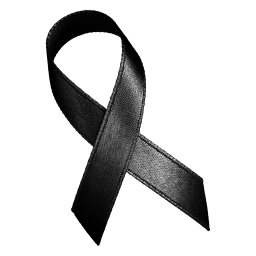Black. Black. Black.
Stand at the entry point of any women’s wear store between the months of September and March and look side to side, front to back. Then, imagine that every black item of clothing in that store disappeared in a blink. What’s left? Not much.
For most of my life I avoided wearing the colour black. Having one’s “colours done” was popular in my young adulthood and black and burgundy were the two colours I was advised to avoid. Orange, green, taupe, brown — those were the colours of autumn and the colours that complimented my skin tone and colouring. I did not do black other than the occasional pair of black pants and black shoes.
But what about when grieving? As we prepared for our mother’s funeral, my sisters and I shopped specifically for black skirts, and sombre attire. Our brother simply put on his black suit.
Our mother owned numerous items of black clothing — useful for funerals and other serious occasions.
Black clothing was once considered a necessary part of one’s wardrobe and essential for mourning. With black now being a winter fashion colour, how can we tell if someone is grieving or simply fashionably dressed? We can’t.
Queen Victoria took wearing black to the extreme. She wore mourning clothing for forty years, nearly the rest of her life, after her husband, Prince Albert, died in 1861. For over ten years, she secluded herself and it was only after her son recovered from typhoid fever, the illness that took her husband, that she showed herself to her subjects in celebration. (see The Widow of Windsor — A Queen in Mourning)
The book The Mourner’s Dance, traces the history of what people do when people die in detail. The author, Katherine Ashenburg, details what they did, what they wore, and how they ritualized and commemorated their loved ones. For centuries in Europe, extending to the colonies, even babies and children dressed in mourning clothes, or with clothing bedecked with black ribbons — even if the deceased was a distant relative. Even pins were available in matte black, so no shiny silver would mar an all black mourning dress. After World War I, somewhat in reaction to Queen Victoria’s protracted mourning, and the reality that much of the world was in mourning, the custom of mourning clothes began to diminish.
That said, here we are in the 21st century and our customs, in many cases, limit grieving to the days after the death, the memorial or funeral experience, and then, it’s back to work, back to life as usual. Walk down the street of any town or city and you will not be able to tell who has experienced a death recently and who has not. Grievers join grief groups and see therapists rather than (although sometimes in addition to) receiving care and compassion from those around them. As a therapist, I have often wished for a visible symbol of mourning that could and would be worn for as long as the griever felt the need for such identification.
I was delighted, therefore, to discover the website Grieving Together. Their home page video, a short cartoon illustrating how simply knowing that someone is grieving can temper the reaction of colleagues and friends. Their founder, Julie, began her journey of grief with the sudden loss of her husband and as part of her commitment to help others, realized that an external symbol of grief was both missing and necessary. For a year, Julie wrapped her wedding ring in black ribbon. Doing so also gave her a symbol with which to mark then end of her first year, the removal of her beribboned ring.
Their business offers pins, ribbons, bracelets and armbands — for both individuals and in wholesale quantities. I hope to offer these to my grieving clients in the near future and invite those who read this blog and who work with grieving individuals to do the same. Thank you, Julie and Rosalind and Cam.
Read more about mourning dress and history:
Mourning Glory: Two centuries of funeral dress
Photo by Francesco Corbisiero on Unsplash

